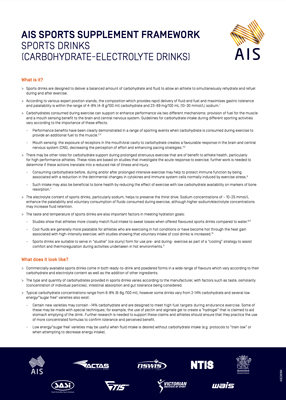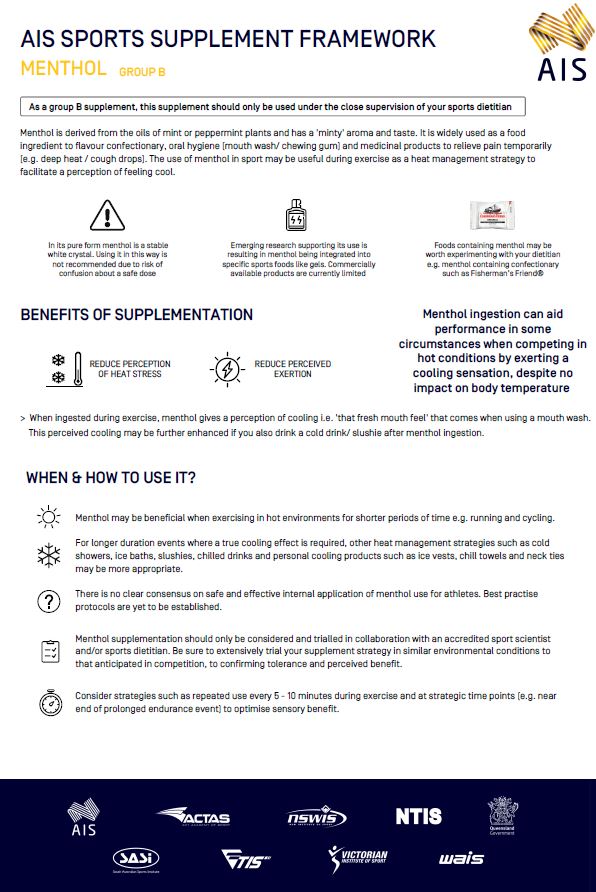Menthol
Menthol
L-Menthol
The use of menthol, when co-ingested with or incorporated into a gel or cold/iced-slurry beverage, may be useful during exercise to facilitate a perception of feeling ‘cool’.

36194_Sport-supplement-fact-sheets-Menthol-v3.pdf

Athlete infographics have been developed for the information of athletes under the direct guidance of a sports dietitian. Sports dietitians have expert knowledge of sports supplements and their potential application in an athletes broader health and performance nutrition strategies. Always engage with a sports dietitian when considering the use of any supplement. https://www.sportsdietitians.com.au/#find-sports-dietitian, opens in a new tab
- The use of menthol, when co-ingested with or incorporated into a gel or cold/iced-slurry beverage, may be useful during exercise to facilitate a perception of feeling ‘cool’.
- Menthol mimics the cold stimulation of thermosensitive neurons (Transient receptor potential melastatin 8; TRPM-8) when applied to mucous membranes.1
- The sensory impact of L-menthol is directly related to the thickness of the skin, density of afferents, concentration of menthol, repetition and length of time of exposure.2
- The internal application of menthol (via mouth rinse or ingestion) is potentially ergogenic when performing endurance activities (>2.5 min) in hot environments by ameliorating athlete’s perception of heat stress by reliably improving thermal sensation, and to a lesser extent, thermal comfort and ratings of perceived exertion in the absence of any change in body (i.e., core and skin) temperature.3
- Further downstream improvements of internal menthol application may include improvements in nasal patency4, alterations in blood flow5 and attenuation of thirst.4
- In its raw form (pharmaceutical grade; 100% pure), menthol is a stable solid white crystal.
- Menthol is a natural compound; the (-) isomer is derived from Mentha species (i.e., peppermint, corn mint) and is associated with a characteristic ‘minty’ aroma, taste and cooling sensation6.
- Menthol is widely used as a food ingredient to flavour confectionary, oral hygiene and medicinal products, and is unlikely to be detrimental o health and/or performance unless recommended protocols regarding frequency and concentration are exceeded.
- Menthol is commercially available through food ingredient (e.g., Melbourne Food Depot) and chemical/laboratory materials supply ompanies (e.g., Sigma Aldrich).
- Currently there is only one commercially available Menthol-containing product range marketed specifically as a sports product (Turbo+, Science in Sport), which is targeted for use during indoor training. However, it has limited availability for purchase in Australia, and contains other ingredients (22 g Carbohydrate, 0.01% active Menthol, 150 mg Caffeine, 1.5 g Beta-alanine, 1.5 g L-Carnitine) which may limit its use to specific sports situations.
- Based on the current understanding of the potential benefits of L-Menthol, individuals may wish to experiment with:
- Ingesting or mouth rinsing a menthol-containing food-grade product (i.e., confectionary such as Fisherman’s Friend - Original).
- There is no clear consensus on safe and effective menthol use for athletes, practitioners or researchers3. Best practice protocols are yet to be established.
- Current guidelines should be followed, which proposes a mouth rinse or beverage containing L-Menthol (0.1 – 0.5 g of crushed L-menthol crystals in 1 L water, equivalent concentration of 0.01 – 0.05% Menthol).7
- L-Menthol supplementation should only be considered and trialled in collaboration with an accredited sport scientist and/or sports dietitian. Individuals should extensively trial intended uses of menthol and pacing strategies under similar environmental conditions prior to implementing in competition, which may include the following strategies:
- Repeated internal application every 5-10 min during exercise.
- Optimising the potential sensory benefits, consider use at strategic time points (e.g., towards the end of a prolonged endurance event).
- The cooling sensation may be heightened if menthol is co-ingested with or incorporated into cold or ice slurry beverages.8
The potential risks of oral menthol application in the heat are not yet fully understood. The following risks have, so far, been identified:
Table 1: Potential Risks of Internal Menthol Use
Concern | |
|---|---|
Toxicity |
|
Unsuitable Dose |
|
Inadvertent Doping |
|
Performance |
|
Thirst Sensation |
|
Manual Handling |
|
Limitations to the current evidence supporting menthol use
High-Performance Environment
- Studies among elite athletes, particularly in events that are representative of real-world performances and conditions (e.g., the degree of thermal discomfort tolerated, motivation for success/resist fatigue) is of high priority.
Sex
- L-menthol research has largely been conducted on male cohorts who are recreationally active or trained. It is not known whether the subtle alterations in sub-elite populations will translate to measurable outcomes for elite athlete in the field.3
- Research on female participants is to be encouraged because of identified sex-differences in olfaction and trigeminal sensitivity.10
Sports/Activities
- More research is warranted on the effects of L-Menthol, on performance of intermittent, dynamic and explosive activities, fine motor movements, or team-based competitive sports due to insufficient research in the field.3
Safety
- To our knowledge, there are no recorded instances of heat-related illness in experiments involving the internal application of L-menthol. Such experiments are ethically bound by strict withdrawal criteria and therefore, careful thermal monitoring during athletic events in less-controlled environments is necessary.
Individual Responses
- Inter-individual difference in response to L-menthol mouth rinsing may be distinguished by the calculation of an individual’s menthol sensitivity index.11
- A clear dose-response has yet to be identified. Individual approaches are warranted above pursuing a ‘more is better’ approach.
Diminishing Returns
- Further understanding of single or repeated mouth rinsing and the reasons for habituation (i.e., diminished response to the repeated application of menthol dose) need to be clarified.
Sports Dietitians Australia Position Statement: Nutrition for Exercise in Hot Environments, opens in a new tab
Supplement safety information www.sportintegrity.gov.au/what-we-do/anti-doping/supplements-sport, opens in a new tab
Material Safety Data Sheet (MSDS) information www.merckmillipore.com/AU/en/product/msds/MDA_CHEM-105995, opens in a new tab
- McKemy, D. TRPM8: The Cold and Menthol Receptor. (2007) In W.B. Liedtke, S. Heller (Eds.) FL, USA: Boca Raton: CRC Press/Taylor & Francis.
- Stevens, Ross & Vogel. (2020). Development of a menthol energy gel for endurance athletes. IJSNEM, 27, 1-6.
- Barwood, Gibson, Gillis et al. (2020). Menthol as an Ergogenic Aid for the Tokyo 2021 Olympic Games: An Expert-Led Consensus Statement Using the Modified Delphi Method. Sports Medicine, 50, 1709-1727.
- Eccles, R. (200). Role of cold receptors and menthol in thirst, the drive to breathe and arousal. Appetite, 34(1), 29-35.
- Kashimaa, H., Hayashiab, N. (2013). Facial skin blood flow responses to irritant stimuli in the oral cavity. Auton Neurosci Basic Clin, 174(1– 2), 61–5.
- Eccles, R. (1994). Menthol and related cooling compounds. J Pharmacy and Pharmacology, 46(8), 618-630.
- Stevens, C. J., & Best, R. (2017). Menthol: A fresh ergogenic aid for athletic performance. Sports Medicine, 47(6), 1035-1042.
- Riera, F., Trong, T.T., Sinnapah, S., Hue, O. (2014). Physical and perceptual cooling with beverages to increase cycle performance in a tropical climate. PLoS One, 9(8).
- Kumar, Baitha, Aggarwal, Jamshed. (2016). A fatal case of menthol poisoning. Int J Appl Basic Med Res, 6(2), 137.
- Hummell, T., Livermore, A. (2002). Intranasal chemosensory function of the trigeminal nerve and aspects of its relation to olfaction. Int Arch Occ Environ Health, 75(5), 305-13.
- Lee, Kakao, Bakri & Tochihara. (2012). Body regional influences of L-Menthol application on the alleviation of heat strain while wearing firefighter’s protective clothing. Eur J App Physiol, 112(6), 2171-83.
- Barwood M, Corbett J, White D, et al. (2012). Early change in thermal perception is not a driver of anticipatory exercise pacing in the heat. Br J Sports Med, 46(13), 936–42.
- Best R, Payton S, Spears I, et al. (2018). Topical and Ingested Cooling Methodologies for Endurance Exercise Performance in the Heat. Sports (Basel), 6(1), 2.
- Flood T. (2018). Menthol Use for Performance in Hot Environments. Curr Sports Med Rep, 17(4), 135-139.
- Flood, Waldron, Jeffries. (2017). Oral L-menthol reduces thermal sensation, increases work-rate and extends time to exhaustion, in the heat at a fixed rating of perceived exertion. Eur J Appl Physiol, 117(7), 1501-1512.
- Galeotti N, Di Cesare Mannelli L, Mazzanti G, Bartolini A, Ghelardini C. Neurosci Lett. (2002). Menthol: a natural analgesic compound. Neurosci, 322(3), 145-8.
- Jeffries O, Waldron M. (2019). The effects of menthol on exercise performance and thermal sensation: A meta-analysis. J Sci Med Sport, 22(6), 707-715.
- Le Meur, Y. (2020) Beating the heat with menthol. YLMSportScience. ylmsportscience.com/2020/12/07/beating-heat-with-menthol, opens in a new tab.
- Mundel, T., & Jones, D. A. (2010). The effects of swilling an L(-)-menthol solution during exercise in the heat. European Journal of Applied Physiology, 109(1), 59-65.
- Stevens & Dascombe. (2015). The reliability and validity of protocols for the assessment of endurance performance: an updated review. Meas Phys Edu Exerc Sci, 19(4), 177-85.
- Stevens, C. J., Thoseby, B., Sculley, D. V., Callister, R., Taylor, L., & Dascombe, B. J. (2016). Running performance and thermal sensation in the heat are improved with menthol mouth rinse but not ice slurry ingestion. Scandinavian Journal of Medicine and Science in Sports, 26(10), 1209-1216.
- Stevens C, Bennett K, Sculley D, et al. (2017). A comparison of mixed-method cooling interventions on preloaded running performance in the heat. J Strength Cond Res, 31(3), 620-29.